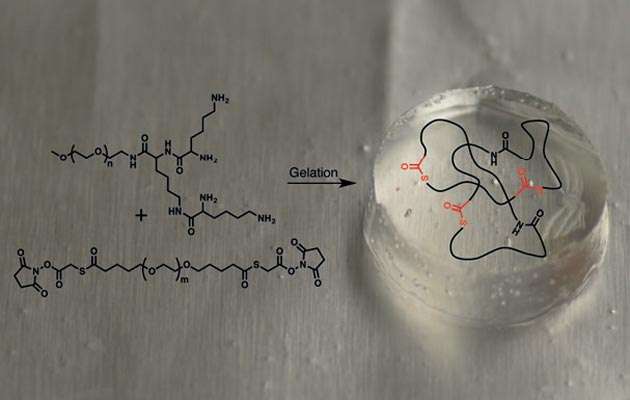July 29, 2016 report
New hydrogel bandage for burns less painful to remove

(Phys.org)—A combined team of researchers from Boston University and Beth Israel Deaconess Medical Center, also in Boston, has published a paper in the journal Angewandte Chemie describing a new type of hydrogel they have developed for use as a bandage for burn patients—one that can be removed by applying another liquid rather than by cutting, as is done with conventional bandages.
Everyone knows that it hurts when your skin is burned, but few people ever have to undergo the excruciatingly painful experience of having bandages replaced after a serious burn—a process called debridement because it involves cutting healthy skin around the burn site—and worse, it must be done over and over while the skin heals. Doctors and patients agree that bandage removal is almost as painful as the initial burn and because of that, researchers have sought a better method. Scientists have searched in vain for a replacement treatment for many years, but now it appears that a breakthrough has finally been made. The team in Boston has created a hydrogel that not only seals burn wounds to prevent entry of bacteria, but can be easily removed by applying an aqueous solution of cysteine methyl ester.
A hydrogel, as its name implies, is a gel that has water as its liquid component. To make one that could be used as a burn bandage, the team combined a polyethylene glycol cross-linker with a lysine-based dendron at the burn site—the two materials then reacted to form a clear hydrogel with adherence properties, and which was also flexible—a must for a bandage that needs to conform to the skin. They report that the hydrogel is also able to remove excess fluid from the wound and maintains a highly humid environment that is conducive to healing.
Thus far, the researchers have only tested their hydrogel on rats with skin burns—such tests so far have proven to be successful, they report—the gel has remained in place and protected the wound and has proven to be easily removable. More tests will have to be done, of course, to ensure that the gel is safe for humans, but the team is optimistic—they hope to launch clinical trials within the next two years.
More information: Marlena D. Konieczynska et al. On-Demand Dissolution of a Dendritic Hydrogel-based Dressing for Second-Degree Burn Wounds through Thiol-Thioester Exchange Reaction, Angewandte Chemie International Edition (2016). DOI: 10.1002/anie.201604827
Abstract
An adhesive yet easily removable burn wound dressing represents a breakthrough in second-degree burn wound care. Current second-degree burn wound dressings absorb wound exudate, reduce bacterial infections, and maintain a moist environment for healing, but are surgically or mechanically debrided from the wound, causing additional trauma to the newly formed tissues. We have developed an on-demand dissolvable dendritic thioester hydrogel burn dressing for second-degree burn care. The hydrogel is composed of a lysine-based dendron and a PEG-based crosslinker, which are synthesized in high yields. The hydrogel burn dressing covers the wound and acts as a barrier to bacterial infection in an in vivo second-degree burn wound model. A unique feature of the hydrogel is its capability to be dissolved on-demand, via a thiol–thioester exchange reaction, allowing for a facile burn dressing removal.
Journal information: Angewandte Chemie International Edition , Angewandte Chemie
© 2016 Phys.org




















